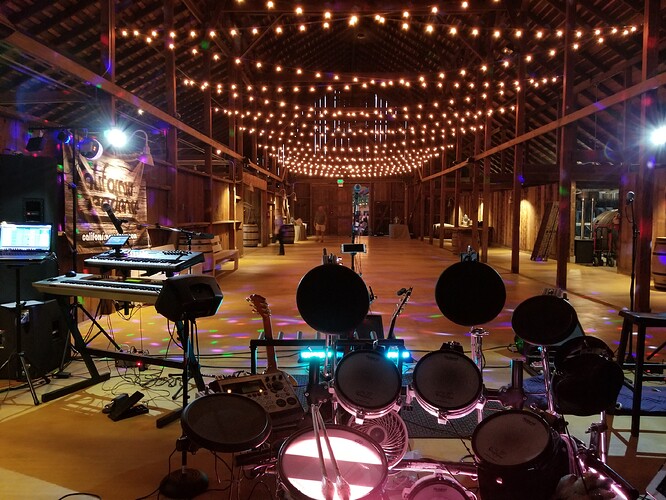I’ve been around long enough to know not to piss off a FOH guy, BUT I absolutely have to bite my tongue occasionally. There is a large venue here that I play regularly, and the sound guy is considered to be the best in the area. Problem is…he also mixes monitors. His FOH is outstanding. BUT, on stage, I cannot hear the opposite side of the stage, which would be guitar and bass. I will say something, and he says"OK", but does nothing. I just have to live with it, and it sucks.
Many times over I agree
That is because we are all deaf from the back breaking huge equipment we used to use.
Dave…are you asking about wireless headphones, or wireless instruments?
Oh, no, Corky I was asking about the remote control mixer unit from Soundcraft from above …
Ok. I am using a QSC with tablets and phones, and it works like a charm. I think there were problems a year ago, and they worked it out. They also found out that a Line 6 amp used the same frequency that interfered with the system network. Don’t know about the Soundcraft.
Thanks for that Corky, that sheds some light on it.
This a request to @terrybritton . On the subject of how you work your craft I am certain it is a lengthly subject to discuss, but I was interested in these streaming music events I thought I heard you describe. Am I correct that you jam or collaborate over the stream? And if so how does this work in general terms. Great thread @Corky
Thanks,
Dave
I was in a band in the late 80s/early 90s that mixed from the stage and had a reputation as one of the best sounding live bands around at the time. We just paralleled our monitor and FoH mixes. The reason it worked was that we had electronic drums (apart from snare and cymbals- but the drummer didn’t play very loud in any event) and we kept our stage volume very low. Basically when we heard what we liked onstage it sounded great out front too.
Thanks for the trip down memory lane! It is funny to me how folks insist that the heavier class A/B amps sound better than the seriously lighter class D. That is a whole can of opinionated worms (including me). In the final analysis, as a die hard class A/B man, I capitulated to all class D. Very light and powerful.
Regarding the SoundCraft UI24R:
About the wireless dropouts. I like to use the analogy of Vodka. If I drink a half pint of vodka, I will begin to feel pretty good, therefore, if I drink a 5th, I will feel great!! The result is a sort of dropped signal (pass out) unless you are Corky.
With wireless mixer users, the above manifests in this way. “My wireless mixer connects via three ways! Hotspot, WiFi AND LAN! If I enable all of them I will have more connectivity, especially if I have all connected!” The conclusion is where the trouble starts. Here is why. You have one Graphical User Interface (GUI) per device. The GUI is reliant on the connection. The connection is varying between enabled protocols (Hotspot, WiFi, LAN) whether disconnected or connected. Why does the HDMI never lose connection, you ask? It is a different source of hardware. Anyway, so if all three connectivity options are enabled the GUI gets “Here I am!” shouted from three directions and it is trying to please them all (sorry for personifying the exchange). GUI says to you who is connected with one of the modalities, “Hold on Dave, I got two other calls. Alright I’m back. Oh wait, someone else is calling, be right back…” The fix? The fewer network protocols enabled, the more reliable the GUI. Can it handle all three at once? Yes. Reliably? No. I always only have one enabled. The Hotspot. No drops. If I choose to use Wifi, or Lan, then disable the hotspot. A common error with users is they think “I will connect the UI24R hard wired to the Ethernet, and leave the Hotspot enabled for the band.” May be okay, but increased probability for lag in fader response and connectivity drops. The worst is when people connect a laptop via ethernet to a router that is transmitting a WiFi signal that the UI24R is connecting to as an access point while the band is using the hotspot to access the wireless mixer on stage. The band will suffer, not the soundman. This is simply a setup for failure, and very poor planning. The range of the hotspot is about 50’ for decent fader response and connection strength. If you switch the UI24R to 5g, your range goes down but your GUI is lightning fast. I use hotspot, disable wifi and LAN, only use 2.4ghz, and account for lag on faders, so I always make fader adjustments smoothly and controlled (as you would with an analog mixer). When setting up, I walk away from the mixer until I see the “connecting” dialogue that indicates it is dropped. Note the distance, account for bodies, then I know my limits, which has always been sufficient, so far.
By the way, another point you brought up reminded me that the UI24R has dbx AFS2!! No anti feedback hardware needed either. It is built in!! I love this thing! It is a great feedback buster. Just turn up the monitor fader while AFS is in “fixed” mode during setup until it tags the offending frequencies, then switch to “live” and it keeps tabs on any changes during the show and knocks out the feedback. Amazing!
If you want a UI24R for cheap, wait for an open box. That is a user who got frustrated due to ignorance, and returned it. That is when you cash in on a great deal, with the benefit of a full warranty!
What does this have to do with C3? C3 integrates fully with the UI24R removing the need for a breakout interface, and it is plenty fast. No performance bottleneck. It handles 32 tracks of audio interface. Your couple of C3 stereo channels are nothing to it. Yes, you will need a long USB cord.
Incredible post John, I learned much from it and thank you again for replying!
Dave
The UI is to the left of my keyboards just out of the picture. To put the UI24R response distance into context, looking out from the band to the guy in the white shorts (if you can see him) is the wireless cutoff distance. The signal cutoff from the perspective of looking toward the band is the other picture.
Loving this thread! My QSC has a screen built in, which usually sits by me, and everyone else uses tablets, and I set the limitations on their connection to their personal monitor mix only. I really don’t know the distance I can get away from the lan, but I usually get out 20 ft from front of speakers when I shoot the room and do other adjustments. My son has a BEHRINGER X32 and seems to do well with his iPad, even tho I have seen many complaints on BEHRINGER mixer lans. BTW…Vodka is my friend 
Rum is mine… we might need a Cantabile libations thread 
I have to say Fred that we have a singer who gets overwhelmed when the stage levels are too loud and goes out of key, but lower the level and back on track. It’s why we did our own sound so much, so we could correct this. And you make a great point about the drums in a band. If the stage is smaller and the room also smaller then it’s just gonna be louder with real drums, so sonic crowding will happen. But if you use electronic drums you can fit into the smaller spaces way better and electronic keyboard and drum mixes that are matched in volume as well and now you don’t really need the metal cymbals as the tech is better. Regular drums never bother me on a big stage or outdoors where they are further away and the sound has somewhere to go besides right through me!
Agreed on sub mixing the keys. I also sub mixed the backtracks to my keyboard levels as well and preferred to give one mix of both.
That is a lengthy discussion, alright! I just added it to my videos list to do a full walk-through of how I use Cantabile, Voicemeeter Pro, and my MOTU 828 mk3 hybrid together to stream through OBS into a YouTube Live Event.
I do not do collaborations (so far) or “jams” with others. There is a software and service that does allow that, but I’ve never used it: https://www.jamkazam.com/ is the only one I know of that permits that in real-time. Kompoz - Music Collaboration Platform has been around for a while for non-real-time collaborations. But I’ve not used either.
Terry
By the way, there are three decent streaming services I’m aware of. I use YouTube, but there is also ConcertWindow and NMBLive. I have accounts with all three, but have only used YouTube thus far.
Terry
Fascinating info Terry, I will wade through it and get up to speed a bit. Thanks for the breadcrumbs …
Dave

